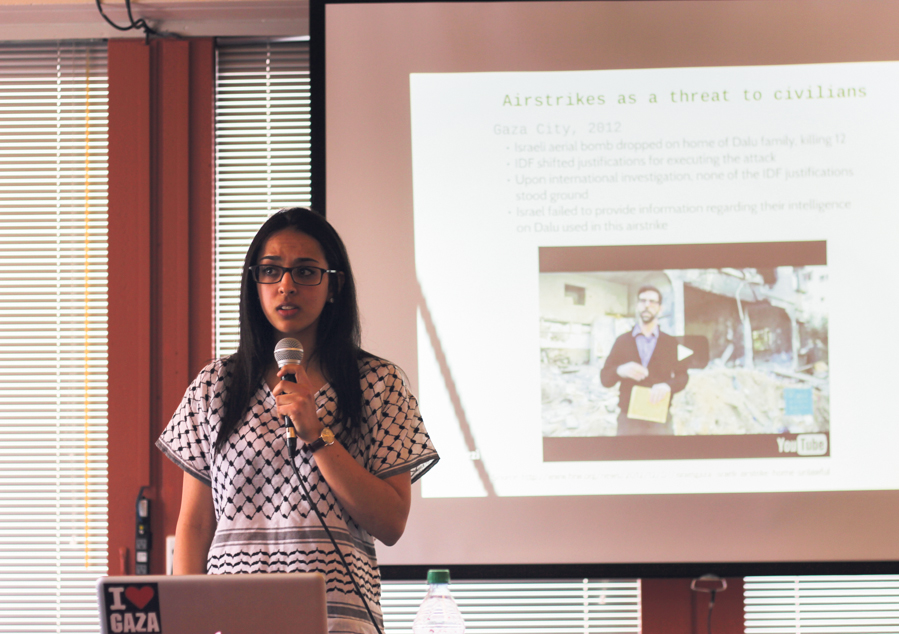Updated February 17, 2014.
On February 12, attendees convened at “The Face of State Violence and Police Brutality in Palestine,” the latest workshop in the Quebec Public Interest Research Group (QPIRG) McGill and the Students’ Society of McGill University (SSMU)’s Social Justice Days 2015 series.
Facilitating the workshop were Maggie Gilligan and Zahra Habib, members of McGill Students in Solidarity for Palestinian Human Rights (SPHR), a student organization that advocates for the rights of the Palestinian people.
The workshop offered an overview and discussion of the ways in which state violence and police brutality are used by Israel against Palestinians as part of a larger apartheid project.
The event began with a discussion of the ways in which state violence manifests visually in the lives of Palestinians, illustrating how these effects originate from institutions, such as the Israeli government and the Israel Defence Forces (IDF), as well as ideologies like racism, Zionism, and settler-colonialism.
“What’s important to understand is that these are not isolated incidents,” said Habib, referencing the Israeli government’s disproportionate use of force. Habib cited the Dahiya doctrine, which calls for the use of asymmetrical warfare as a means of deterrence. Habib said that, although this doctrine violates the principle of proportionality in international law, it manifests itself on a daily basis for Palestinians through large-scale aerial raids (such as in Gaza last summer), home raids and demolitions, and arbitrary arrests, even of children.
Gilligan told The Daily that this kind of workshop is an important counterbalance to the dehumanizing effects of the Israeli and Western media. “The state violence perpetuated by the Israeli government is a very important part of the narrative of the Israel-Palestine conflict, and it is a part that is missed at best and silenced at worst,” she said. “So we think it is important to put forth the voices of civilians and children who have been harmed by state-sanctioned policies, and make sure everyone’s story is being told.”
One topic discussed was how to unpack the way Israeli and Western media tends to dehumanize Palestinians, and portray instances of state violence as responses to Palestinian dissidence.
In the discussion, workshop attendee Nadir Khan asserted that the world knows Israelis are using disproportionate force against Palestinians, but the magnitude of the violence and damage does not seem to resonate enough for the international community to demand change. Khan went on to question what students could do to bring about concrete change.
“The state violence perpetuated by the Israeli government is a very important part of the narrative of the Israel-Palestine conflict, and it is a part that is missed at best and silenced at worst.”
Ralph Haddad, a U2 Middle Eastern Studies and Women’s Studies stdent and former Daily editor, suggested countering the Israeli public relations machine as a method. “We should employ emerging media that exist outside of that sphere to further our own cause […] because Israel is known to employ students and employees in giant operations, using Facebook and Twitter and social media to spread propaganda to gain sympathy for the IDF. There is no way to counter that without stopping [the perpetration of] our own rhetoric.”
Haddad also stressed the need to recognize the connections between Palestinian struggles and other struggles. Intersectionality “makes us stronger,” he said.
During the workshop, Gilligan highlighted increasing awareness of the intersectionality between black struggles in the U.S. and those in Palestine, as both governments respond to dissent with similar repression. “It’s important to make this connection because they stem from the same place and I think a lot of similar strategies can be used to combat them. And again another direct link is that one of the police forces that was used in
Ferguson to calm protesters was trained by the IDF. So we have the policy links, the theoretical links, we also have a lot of direct links that are a lot closer than we think.”

